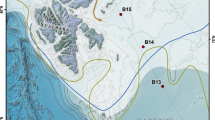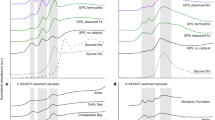Abstract
Purpose
Despite occupying only 0.5% of the global coastal ocean, mangroves play a disproportionately large role in the capture and retention of atmospheric carbon dioxide as organic carbon (OC) in its sediments. However, the capacity of mangrove sediments to store high amounts of OC has never been explained mechanistically. This study elucidates the role of reactive iron (FeR) in long-term carbon sequestration in mangrove sediments.
Materials and methods
Sediment samples of up to 1 m in depth were collected from six selected mangrove areas across the Philippines. The samples were characterized using X-ray diffraction (XRD) and X-ray fluorescence (XRF). A citrate-bicarbonate-dithionite reduction procedure was employed to extract FeR from the sediments. The OC concentration and δ13C signatures before and after FeR extraction were determined using a dichromate oxidation technique and isotope ratio mass spectrometry (IRMS), respectively.
Results and discussion
XRD diffractograms showed that the mangrove sediment samples varied in terms of mineralogical characteristics, which reflected their different parent materials. It was found that the OC concentration increased exponentially (OC = 8.38e0.37FeR; R2 = 0.88; p < 0.0001) with increasing FeR concentration. δ13C signatures of FeR-associated OC revealed that FeR preferentially preserved terrestrial over marine-derived organic matter. Finally, FeR was estimated to coprecipitate with up to 5.44 × 1012 g OC in mangrove sediments per year.
Conclusions
The findings of this study suggest that FeR is responsible for the preservation of OC, thus making mangrove sediments a “giant rusty sponge” for carbon. This mechanistic understanding of the long-term carbon storage in mangrove sediments could help draft better strategies for blue carbon initiatives that include the mangrove ecosystems.



Similar content being viewed by others
References
Ajonina G, Kairo JG, Grimsditch G, Sembres T, Chuyong G, Mibog DE, Nyambane A, FitzGerald C (2014) Carbon pools and multiple benefits of mangroves in Central Africa: Assessment for REDD+. 72 pp
Alongi DM (2009) The energetics of mangrove forests. Springer Netherlands, Dordrecht
Alongi DM (2014) Carbon cycling and storage in mangrove forests. Annu Rev Mar Sci 6:195–219
Barber A, Brandes J, Leri A, Lalonde K, Balind K, Wirick S, Wang J, Gélinas Y (2017) Preservation of organic matter in marine sediments by inner-sphere interactions with reactive iron. Sci Rep 7:366
Barber A, Lalonde K, Mucci A, Gélinas Y (2014) The role of iron in the diagenesis of organic carbon and nitrogen in sediments: a long-term incubation experiment. Mar Chem 162:1–9
Berner RA (1970) Sedimentary pyrite formation. Am J Sci 268:1–23
Boudot JP, Bel Hadj^Brahim A, Steiman R, Seigle-Murandi F (1989) Biodegradation of synthetic organo-metallic complexes of iron and aluminum with selected metal to carbon ratios. Soil Biol Biochem 21:961–966
Bouillon S, Connolly RM, Lee SY (2008) Organic matter exchange and cycling in mangrove ecosystems: recent insights from stable isotope studies. J Sea Res 59:44–58
Breithaupt JL, Smoak JM, Smith TJ, Sanders CJ, Hoare A (2012) Organic carbon burial rates in mangrove sediments: strengthening the global budget. Glob Biogeochem Cycles 26:1–11
Brodie CR, Leng MJ, Casford JSL, Kendrick CP, Lloyd JM, Yongqiang Z, Bird MI (2011) Evidence for bias in C and N concentrations and δ13C composition of terrestrial and aquatic organic materials due to pre-analysis acid preparation methods. Chem Geol 282:67–83
Burdige DJ (2007) Preservation of organic matter in marine sediments: controls, mechanisms, and an imbalance in sediment organic carbon budgets? Chem Rev 107:467–485
Canfield DE (1989) Reactive iron in marine sediments. Geochim Cosmochim Acta 53:619–632
Cardona P, Botero L (1998) Soil characteristics and vegetation structure in a heavily deteriorated mangrove forest in the Caribbean coast of Colombia. Biotropica 30:24–34
Chen C, Dynes JJ, Wang J, Sparks DL (2014) Properties of Fe-organic matter associations via coprecipitation versus adsorption. Environ Sci Technol 48:13751–13759
Chen C, Kukkadapu R, Sparks DL (2015) Influence of coprecipitated organic matter on Fe2+(aq)-catalyzed transformation of ferrihydrite: implications for carbon dynamics. Environ Sci Technol 49(18):10927–10936
Donato DC, Kauffman JB, Murdiyarso D, Kurnianto S, Stidham M, Kanninen M (2011) Mangroves among the most carbon-rich forests in the tropics. Nat Geosci 4:293–297
Duarte CM, Middelburg JJ, Caraco N (2005) Major role of marine vegetation on the oceanic carbon cycle. Biogeosciences 1:659–679
Ellison JC, Stoddart DR (1991) Mangrove ecosystem collapse during predicted sea-level rise: Holocene analogues. J Coast Res 7:151–165
Farquhar GD, Ehleringer JR, Hubick KT (1989) Carbon isotope discrimination and photosynthesis. Annu Rev Plant Physiol Plant Mol Biol 40:503–537
Field CD (1995) Impact of expected climate change on mangroves. Hydrobiologia 295:75–81
Friess DA (2013) Tropical wetlands and REDD+: three unique scientific challenges for policy. Int J Rural Law P 1:1–6
Gleason SM, Ewel KC, Hue N (2003) Soil redox conditions and plant-soil relationships in a Micronesian mangrove forest. Estuar Coast Shelf Sci 56:1065–1074
Haese RR, Wallmann K, Dahmke A, Kretzmann U, Müller PJ, Schulz HD (1997) Iron species determination to investigate early diagenetic reactivity in marine sediments. Geochim Cosmochim Acta 61:63–72
Hamilton SE, Friess DA (2018) Global carbon stocks and potential emissions due to mangrove deforestation from 2000 to 2012. Nat Clim Chang 8:240–244
Hedges JI, Keil RG (1995) Sedimentary organic matter preservation: an assessment and speculative synthesis. Mar Chem 49:137–139
IPCC (2007) Fourth assessment report of the IPPCC. Cambridge University Press, New York
Kaiser K, Guggenberger G (2000) The role of DOM sorption to mineral surfaces in the preservation of organic matter in soils. Org Geochem 31:711–725
Keil R (2017) Anthropogenic forcing of carbonate and organic carbon preservation in marine sediments. Annu Rev Mar Sci 9:151–172
Kennedy P, Kennedy H, Papadimitriou S (2005) The effect of acidification on the determination of organic carbon, total nitrogen and their stable isotopic composition in algae and marine sediment. Rapid Commun Mass Spectrom 19:1063–1068
Kitaya Y, Yabuki K, Kiyota M, Tani A, Hirano T, Aiga I (2002) Gas exchange and oxygen concentration in pneumatophores and prop roots of four mangrove species. Trees 16:155–158
Kristensen E (2008) Mangrove crabs as ecosystem engineers; with emphasis on sediment processes. J Sea Res 59:30–43
Kristensen E, Bouillon S, Dittmar T, Marchand C (2008) Organic carbon dynamics in mangrove ecosystems: a review. Aquat Bot 89:201–219
Lalonde K, Mucci A, Ouellet A, Gélinas Y (2012) Preservation of organic matter in sediments promoted by iron. Nature 483:198–200
Lehmann J, Kleber M (2015) Perspective. The contentious nature of soil organic matter. Nature 528:60–68
Lim AB, Sta. Maria E, Ebreo CM, Ramirez J, Castro KM, Garcia MC, Navarrete I. Salmo SG III (2015) Preliminary evaluation of sedimentation rates in Philippine mangrove forests using 210Pb dating technique. Paper presented at the 13th National Symposium in Marine Science held in General Santos City on 22–24 October 2015
Locatelli T, Binet T, Kairo JG, King L, Madden S, Patenaude G, Upton C, Huxham M (2014) Turning the tide: how blue carbon and payments for ecosystem services (PES) might help save mangrove forests. Ambio 43:981–995
Marchand C, Baltzer F, Lallier-Verges E, Alberic P (2004) Pore-water chemistry in mangrove sediments: relationship with species composition and developmental stages (French Guiana). Mar Geol 208:361–381
Mackey DJ, Zirino A (1994) Comments on trace metal speciation in seawater or do “onions” grow in the sea? Anal Chim Acta 284:635–647
McLeod E, Chmura GL, Bouillon S, Salm R, Björk M, Duarte CM, Lovelock C, Schlesinger WH, Silliman BR (2011) A blueprint for blue carbon: toward an improved understanding of the role of vegetated coastal habitats in sequestering CO2. Front Ecol Environ 9:552–560
Mehra OP, Jackson ML (1958) Iron oxide removal from soils and clays by a dithionite-citrate system buffered with sodium bicarbonate. Clay Clay Miner 7:317–327
Murdiyarso D, Purbopuspito J, Kauffman JB, Warren MW, Sasmito SD, Donato DC, Manuri S, Krisnawati H, Taberima S, Kurnianto S (2015) The potential of Indonesian mangrove forests for global climate change mitigation. Nat Clim Chang 5:1089–1092
Nam VN, Sasmito SD, Murdiyaso D, Purbopuspito J, MacKenzie RA (2016) Carbon stocks in artificiallyand naturally regenerated mangrove ecosystems in the Mekong Delta. Wetl Ecol Manag 24:231–244
Navarrete IA, Gabiana CC, Dumo JRE, Salmo SG III, Guzman MALG, Valera NS, Espiritu EQ (2017) Heavy metal concentrations in soils and vegetation in urban areas of Quezon City, Philippines. Environ Monit Assess 189:145
Ovalle ARC, Rezende CE, Lacerda LD, Silva CAR (1990) Factors affecting the hydrochemistry of a mangrove tidal creek, Sepetiba Bay, Brazil. Estuar Coast Shelf Sci 31:639–650
Poulton SW, Raiswell R (2005) Chemical and physical characteristics of iron oxides in riverine and glacial meltwater sediments. Chem Geol 218:203–221
Phang VXH, Chou LM, Friess DA (2015) Ecosystem carbon stocks across a tropical intertidal habitat mosaic of mangrove forest, seagrass meadow, mudflat and sandbar. Earth Surf Process Landf 40:1387–1400
Primavera JH, Rollon RN, Samson MS (2012) The pressing challenges of mangrove rehabilitation: pond reversion and coastal protection. In: Wolanski E, McLusky D (eds) Treatise on estuarine and coastal science. Academic Press, Waltham, pp 217–244
Rahmstorf S (2007) A semi-empirical approach to projecting future sea-level rise. Science 315:368–370
Riedel T, Zak D, Biester H, Dittmar T (2013) Iron traps terrestrially derived dissolved organic matter at redox interfaces. Proc Natl Acad Sci U S A 110:10101–10105
Salmo SGIII, Lovelock CE, Duke NC (2013) Vegetation and soil characteristics as indicators of restoration trajectories in restored mangroves. Hydrobiologia 720:1–18
Salmo SG III, Lovelock CE, Duke NC (2014) Assessment of vegetation and soil conditions in restored mangroves interrupted by severe tropical typhoon ‘Chan-hom’ in the Philippines. Hydrobiologia 733:85–102
Scharlemann JP, Tanner EV, Hiederer R, Kapos V (2014) Global soil carbon: understanding and managing the largest terrestrial carbon pool. Carbon Manag 5:81–91
Schwertmann U (1966) Inhibitory effect of soil organic matter on the crystallization of amorphous ferric hydroxide. Nature 212:645–646
Shields MR, Bianchi TS, Gélinas Y, Allison MA, Twilley RR (2016) Enhanced terrestrial carbon preservation promoted by reactive iron in deltaic sediments. Geophys Res Lett 43:1149–1157
Siikamaki J, Sanchirico JN, Jardine SL (2012) Global economic potential for reducing carbon dioxide emissions from mangrove loss. Proc Natl Acad Sci U S A 109:14369–14374
Skelton NJ, Allaway WG (1996) Oxygen and pressure changes measured in situ during flooding in roots of the Grey Mangrove Avicennia marina (Forssk.) Vierh. Aquat Bot 54:165–175
Syvitski JPM, Milliman JD (2007) Geology, gography, and humans battle for dominance over the delivery of fluvial sediment to the coastal ocean. J Geol 115:1–19
Syvitski JPM, Vörösmarty CJ, Kettner AJ, Green P (2005) Impact of humans on the flux of terrestrial sediment to the global coastal ocean. Science 308:376–380
Tinsley J (1950) The determination of organic carbon in soils by dichromate mixtures. Transactions 4th Int Cong Soil Sci 1:161–164
Ullman R, Bilbao-Bastida V, Grimsditch G (2013) Including blue carbon in climate market mechanisms. Ocean Coast Manag 83:15–18
Van der Zee C, Roberts DR, Rancourt DG, Slomp CP (2003) Nanogoethite is the dominant reactive oxyhydroxide phase in lake and marine sediments. Geology 31:993–996
Wang XC, Druffel ERM, Griffin S, Lee C, Kashgarian M (1998) Radiocarbon studies of organic compound classes in plankton and sediment of the northeastern Pacific Ocean. Geochim Cosmochim Acta 62:1365–1378
Wilson MJ (1999) The origin and formation of clay minerals in soils: past, present and future perspectives. Clay Miner 34:7–25
Funding
This study was supported by the Department of Science and Technology Accelerated Science and Technology Human Resource Development Program—National Science Consortium (DOST ASTHRDP-NSC); the Philippine Nuclear Research Institute Graduate Student Research Grant Program (PNRI GSRGP), with funding from the Philippine Council for Industry, Energy and Emerging Technologies (PCIEERD); and the United States Agency for International Development (USAID) through the Partnership for Enhanced Engagement in Research (PEER) of the National Science Foundation (NSF; Project 3-191). The University Research Council of Ateneo de Manila University has granted a research faculty fellowship to Ian A. Navarrete during the preparation of the manuscript.
Author information
Authors and Affiliations
Corresponding author
Additional information
Responsible editor: Haihan Zhang
Rights and permissions
About this article
Cite this article
Dicen, G.P., Navarrete, I.A., Rallos, R.V. et al. The role of reactive iron in long-term carbon sequestration in mangrove sediments. J Soils Sediments 19, 501–510 (2019). https://doi.org/10.1007/s11368-018-2051-y
Received:
Accepted:
Published:
Issue Date:
DOI: https://doi.org/10.1007/s11368-018-2051-y




